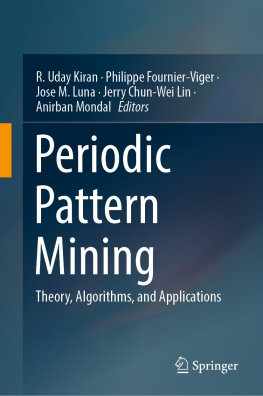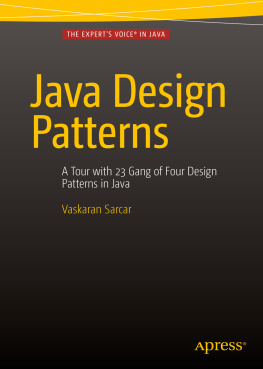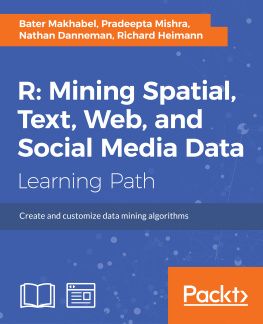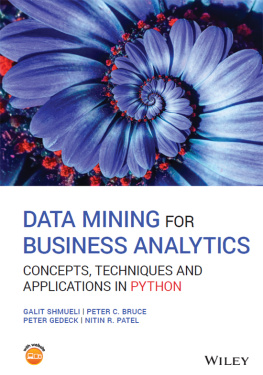Editors
R. Uday Kiran
Division of Information Systems, University of Aizu, Aizu-Wakamatsu, Fukushima, Japan
Philippe Fournier-Viger
College of Computer Science and Software Engineering, Shenzhen University, Shenzhen, Guangdong, China
Jose M. Luna
Department of Computer Science and Numerical Analysis, University of Crdoba, Crdoba, Spain
Jerry Chun-Wei Lin
Department of Computer Science, Electrical Engineering, and Mathematical Sciences, Western Norway University of Applied Sciences, Bergen, Norway
Anirban Mondal
Department of Computer Science, Ashoka University, Sonepat, Haryana, India
ISBN 978-981-16-3963-0 e-ISBN 978-981-16-3964-7
https://doi.org/10.1007/978-981-16-3964-7
The Editor(s) (if applicable) and The Author(s), under exclusive license to Springer Nature Singapore Pte Ltd. 2021
This work is subject to copyright. All rights are solely and exclusively licensed by the Publisher, whether the whole or part of the material is concerned, specifically the rights of translation, reprinting, reuse of illustrations, recitation, broadcasting, reproduction on microfilms or in any other physical way, and transmission or information storage and retrieval, electronic adaptation, computer software, or by similar or dissimilar methodology now known or hereafter developed.
The use of general descriptive names, registered names, trademarks, service marks, etc. in this publication does not imply, even in the absence of a specific statement, that such names are exempt from the relevant protective laws and regulations and therefore free for general use.
The publisher, the authors and the editors are safe to assume that the advice and information in this book are believed to be true and accurate at the date of publication. Neither the publisher nor the authors or the editors give a warranty, expressed or implied, with respect to the material contained herein or for any errors or omissions that may have been made. The publisher remains neutral with regard to jurisdictional claims in published maps and institutional affiliations.
This Springer imprint is published by the registered company Springer Nature Singapore Pte Ltd.
The registered company address is: 152 Beach Road, #21-01/04 Gateway East, Singapore 189721, Singapore
Preface
Technological advances in the field of Information and Communication Technologies (ICTs) have facilitated organizations to collect, store, and process massive amounts of data. Useful information that can empower the end-users to achieve socio-economic development lies in this data. However, finding interesting information in data can be very challenging due to the sheer scale of the data. In the last decades, researchers from the field of data mining have aimed at tackling this challenge by proposing various techniques to discover knowledge hidden in voluminous real-world data. Over the years, data mining has received more and more attention from both industry and academia. Pattern mining is one of the fundamental knowledge discovery techniques used in data mining. It involves discovering all user interest-based patterns in a database. Much of the past research on pattern mining has focused on utilizing the frequency-based measures to discover different types of interesting patterns such as frequent patterns, correlated patterns, top-  frequent patterns, maximal frequent patterns, closed frequent patterns, rare patterns, coverage patterns, high utility patterns, and emerging patterns.
frequent patterns, maximal frequent patterns, closed frequent patterns, rare patterns, coverage patterns, high utility patterns, and emerging patterns.
Although discovering frequent patterns in a database is beneficial for many applications, frequency may not always be enough to find user interest-based patterns, especially if the data contains temporal information. For example, the user may consider an irregularly occurring frequent pattern to be less interesting over a regularly occurring infrequency (or rare) pattern in the data. Based on this observation, efforts have been put forth in the literature to discover periodically occurring patterns (or periodic patterns) in a temporal database. Since real-world data often contain temporal information, finding periodic patterns has received a great deal of attention. Furthermore, periodic pattern mining has been extended to consider other forms of data, such as quantitative temporal databases and sequences.
From a research perspective, discovering periodic patterns is more challenging than frequent pattern mining. It is because of two main reasons: (  ) we need to explore new measures to determine the interestingness of a pattern in the
) we need to explore new measures to determine the interestingness of a pattern in the  dimension, and (
dimension, and (  ) we need to investigate new data structures to effectively record the temporal occurrence information of a pattern in the database. Thus, traditional frequent pattern mining techniques cannot be directly used for finding periodic patterns. In the last decade, this has led to the proposal of many new interestingness measures and novel data structures to discover periodic patterns.
) we need to investigate new data structures to effectively record the temporal occurrence information of a pattern in the database. Thus, traditional frequent pattern mining techniques cannot be directly used for finding periodic patterns. In the last decade, this has led to the proposal of many new interestingness measures and novel data structures to discover periodic patterns.
The main motivation for writing this book is that the research on periodic pattern mining has become quite mature. There is thus a need to provide an up-to-date introduction, overview of current techniques, and recent advances in periodic pattern mining. The book is a collection of chapters written by experienced researchers who published several papers on the related topic in top conferences and major journals. The chapters were selected to ensure that the key topics and techniques in periodic pattern mining are discussed. Several of the chapters are written as survey papers to give a broad overview of current work in periodic pattern mining, while other chapters present techniques and applications in more detail. The book is designed so that it can be used both by researchers and people who are new to the field. Selected chapters from this book could be used to teach an advanced undergraduate or graduate course on pattern mining. Besides, the book provides enough details about state-of-the-art algorithms so that it could be used by industry practitioners who want to implement periodic pattern mining techniques in commercial software, to analyze temporal database. Several of the algorithms discussed in this book are implemented in the open-source PAttern MIning (PAMI) software, which is available at https://github.com/udayRage/PAMI . Anyone can download this software through pip install pami.











 frequent patterns, maximal frequent patterns, closed frequent patterns, rare patterns, coverage patterns, high utility patterns, and emerging patterns.
frequent patterns, maximal frequent patterns, closed frequent patterns, rare patterns, coverage patterns, high utility patterns, and emerging patterns. ) we need to explore new measures to determine the interestingness of a pattern in the
) we need to explore new measures to determine the interestingness of a pattern in the  dimension, and (
dimension, and (  ) we need to investigate new data structures to effectively record the temporal occurrence information of a pattern in the database. Thus, traditional frequent pattern mining techniques cannot be directly used for finding periodic patterns. In the last decade, this has led to the proposal of many new interestingness measures and novel data structures to discover periodic patterns.
) we need to investigate new data structures to effectively record the temporal occurrence information of a pattern in the database. Thus, traditional frequent pattern mining techniques cannot be directly used for finding periodic patterns. In the last decade, this has led to the proposal of many new interestingness measures and novel data structures to discover periodic patterns.